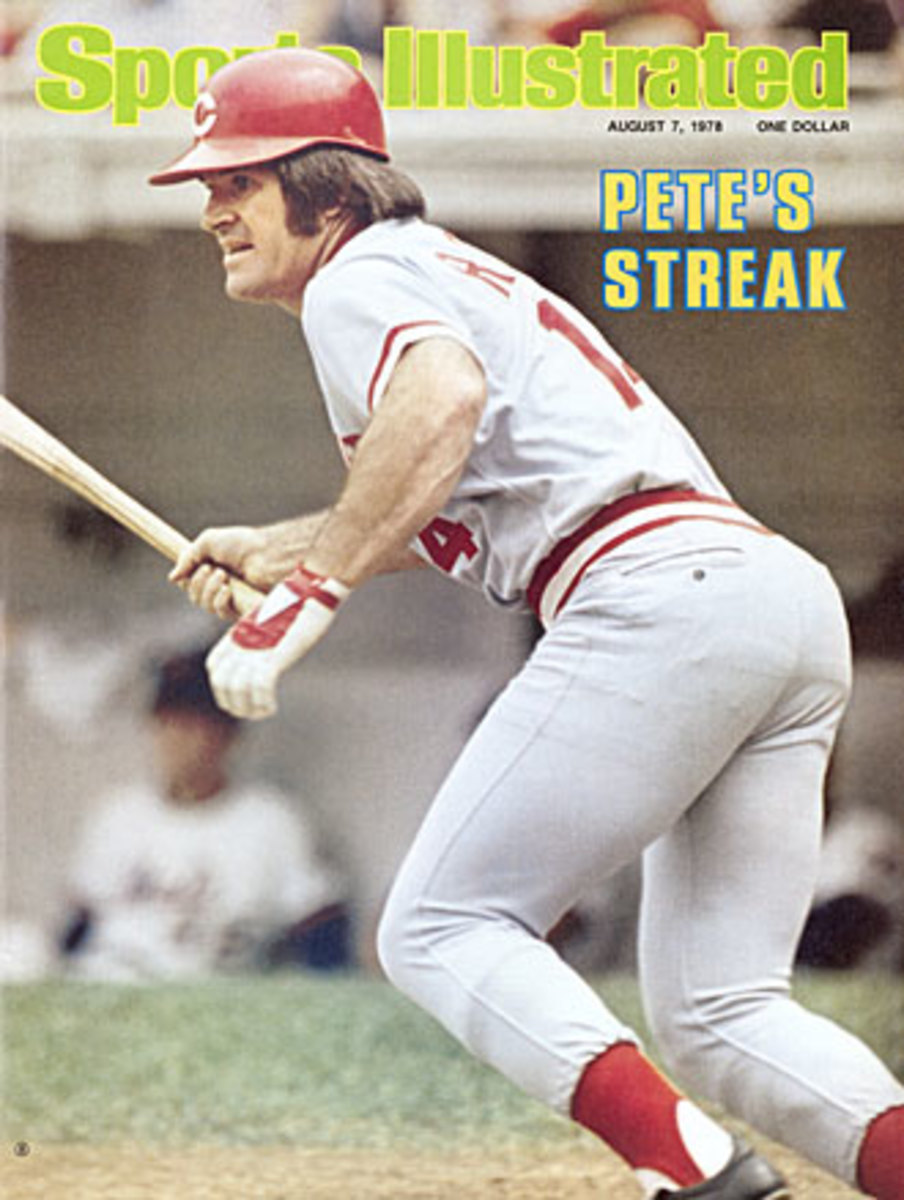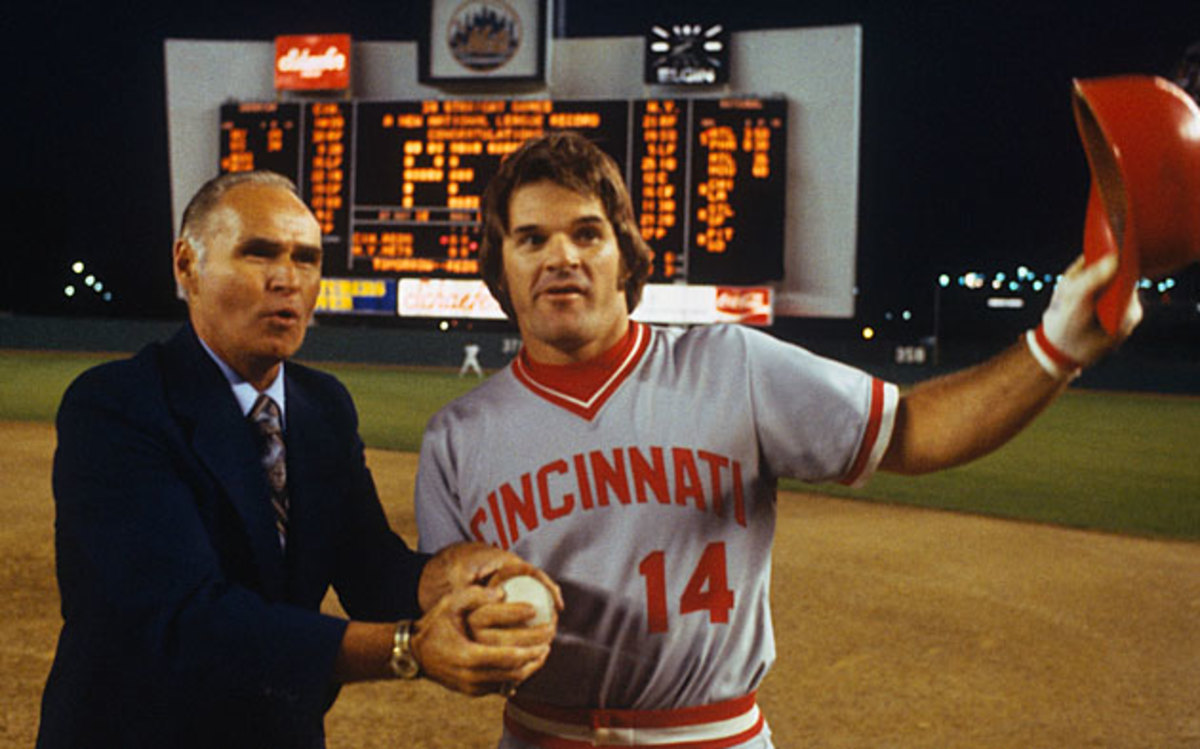SI Vault: Much Ado: Pete Rose chases Joe DiMaggio's sacred hitting streak

This story appeared in the Aug. 7, 1978 issue of SPORTS ILLUSTRATED.
Pete Rose was sitting alone before his dressing cubicle in the Cincinnati clubhouse one day last week, sifting through another bushel of letters and telegrams. Across the room a tape deck played a song from Saturday Night Fever, and at that moment Staying Alive seemed particularly appropriate to Rose. On Wednesday, June 14 Pete broke out of a 5-for-44 batting slump with two hits against the Cubs, and he has been staying alive ever since. In the top of the first and the bottom of the ninth, with precise bunts, line-drive singles and Charlie Hustle doubles, Rose had fashioned the second-longest hitting streak since the days of the handlebar mustache.
At the end of last week his .387 tear against eight teams had raised his average from .267 to .315, and along the way he had said hello and goodby to notable streakers from every baseball generation. Rose caught up with the modern Reds' record holders, Edd Roush (1920 and '24) and Vada Pinson (1965), in Game 27, with switch-hitting leader Red Schoendienst (1954) in Game 28 and, early last week, with modern National League record-setter Tommy Holmes (1945) in Game 37. In ensuing days he would equal Ty Cobb's 40-game string of 1911, George Sisler's 41 of 1922 and Bill Dahlen's 42 of 1894. Finally, the only person between Rose and Joe DiMaggio and his "unbreakable" major league standard of 56 in 1941 was Willie Keeler, who established the alltime National League record in 1897 by hitting 'em where they weren't in 44 straight games.Rose took care of Keeler, too, on Monday night in Atlanta.
Rose's streak provided plenty of drama even before Wee Willie and Joltin' Joe heaved into view. And he kept it going without any assistance from kindly official scorers or bonus turns at the plate in extra-inning games. Six times he saved himself with hits in his last at bat; four times his only hit was a bunt. Almost all of his closest calls came against Philadelphia: in Games 32 and 41 he dropped perfect bunts in front of Phillie Third Baseman Mike Schmidt, and he barely survived a dazzling catch and throw by Second Baseman Ted Sizemore to beat out his only hit of Game 33. "Pete gave me two chances to stop the streak, and I didn't do it either time," says Schmidt, a Gold Glove fielder. "He'd never bunted on me before, and then he laid down two perfect ones that I couldn't come up with. I've really got to respect him. He's the epitome of concentration. He's turned into my idol."
SI Vault Podcast: Larry Keith on Pete Rose and his forgotten excellence
Of all the accomplishments of Rose's lustrous 16-year career, none brought quite the acclaim that was generated by the streak. He has been Rookie of the Year and MVP, he has played in 11 All-Star Games and four World Series, he has led the league in hitting three times, and on May 5 of this year he got his 3,000th hit. But all those achievements were just a prelude to the streak, which, says teammate Tom Seaver, "is a reaffirmation" of who Pete Rose really is.
Last week Rose taped segments for Good Morning America with David Hartman, Today with Dick Schaap and Donahue with Phil Donahue. He endured media blitzes before and after every game and in between games of a doubleheader. He received telegrams from a stripper and a governor, notes of congratulation from former teammates, a card of thanks from the vendors at Shea Stadium, a phone call from a Jimmy Carter impersonator and loud cheers every time he showed his head outside the dugout. Unlike many of today's athletes who complain about the pressures of fame in their moments of triumph, Rose maintained his composure, his wit and his batting stroke through it all. "If this were some other player, it might cause problems," said Manager Sparky Anderson, "but not with Pete. He represents us."
It was true, as one New York City cop shouted to him, "Your life's not your own, Pete," but Rose did not seem to mind. "I like pressure situations," he says. "They're fun. When people are urging me on, I can do things that are impossible sometimes."
Rose had other motivations as well. "Baseball is a team sport," he says, "but you get paid for what you do as an individual. My contract expires at the end of this season, and I want to prove I can still play. It would be nice to win the batting title at 37."

Rose may be advanced in baseball years, but the best he could do as a younger man was a streak of 25 games in 1967. In starting this tear,Rose broke 'out of one of the worst slumps of his career. Among the reasons for the turnabout were some minor technical adjustments at the plate. Rose began choking up more and spreading his stance wider. For some reason, he also started seeing the ball better, picking up the rotation as soon as it left the pitcher's hand. "That little white rat looks like a big white rat," he said. As a result, when he chose to swing, he made contact—he had only five strikeouts in the six weeks since his string began—and he hit the ball sharply. "With any luck at all I'd be hitting over .400 in this streak," Rose said, "but I've hit a lot of balls hard that were caught." Finally, he rediscovered his righthanded stroke, bringing grief to lefthanders (.364) and righthanders (.402) alike. Before the streak started, his average against lefties was .229.
Even with all of this going for him, it looked for a while last week as if Rose might not catch Holmes. In his first three appearances in Game 37 on July 24 against the Mets' Pat Zachry, he flied out twice and hit into a fielder's choice. Following each failure, he returned to sit in silence in the dugout. Anderson thought that, for once, Rose was pressing too hard. When Pete came up again in the seventh, many of the 40,065 stood in nervous anticipation of what figured to be his last turn at the plate. Rose bunted the first pitch foul and then took a ball high and outside. Zachry's third delivery was a changeup. Rose jumped on it, lining the pitch to leftfield to tie Holmes' record. At first base, he accepted the congratulations of Coach Ron Plaza, Umpire Joe West and Met First Baseman Willie Montanez. As the crowd continued an ovation that lasted three minutes, Montanez advised Rose, "Take your hat off or we'll be here all night."
The following day Rose traveled to Shea in a limousine provided by the makers of one of the products he endorses. He seemed more relaxed and confident than the day before. "You don't really accomplish anything if you just tie somebody," he said. Rose hit the ball with solid thwacks in batting practice, which, he feels, is always a good sign, and he connected even harder once the game began. Facing Craig Swan, he flied out in his first appearance but hit safely in his next three. "He broke the record three times," Swan said. It was a line drive to left in the third that did the job officially. As soon as the ball was returned to the infield, the umpires called time for a brief ceremony, and Swan, Montanez and Catcher John Stearns obligingly left the field lest they clutter up Rose's moment.

When Holmes set the record 33 years ago, he was an outfielder for the Braves. These days, as fate would have it, he works in the Mets' community relations department. He joined Rose on the field for pictures, and when Rose tried to give him the ball as a memento, Holmes said, "No, it belongs to you, Pete." Afterward Holmes said he did not mind relinquishing the record to Rose. On the contrary, it was nice that people were remembering him again, and nice that he could relive the way it used to be. "It was like I was doing it all over," he said. "I was living and dying with every pitch. Now when I teach the kids, they'll know who I am. They'll listen to me. I'll tell them to play the game like Pete Rose."
After Holmes returned to his obscure corner, Rose set out after the five men who remained ahead of him, particularly Cobb and Keeler. "I feel like I know Cobb," he says. "I heard a lot about him early in my career from Waite Hoyt, who played against him, and I'm reading his biography now. I think we're a lot alike. He was small, tough and liked to fight. He once fouled 16 straight balls into the Yankee dugout. Do you know how hard that is to do?"
Even more important than surpassing Cobb's streak was catching Keeler. Rose wanted all of the National League record, not just the "modern" half he had taken from Holmes. "I'm a National Leaguer and so was Keeler," Rose said. "What difference does it make that he played before 1900 or after 1900?"
Rose's attitude was commendable, especially because baseball's record keepers distinguish between pre-and post-1900 accomplishments. Though Keeler performed under basically the same rules as Rose does—except that fouls did not count as strikes before 1901—many baseball men view his accomplishments with skepticism. "I don't even consider it baseball," says Sparky Anderson. "It's like comparing a jet with a prop."
Nor did Anderson believe that Rose had much chance of catching DiMaggio. "I don't think anybody can do it," he said. "Too many things can go wrong. Seeing Pete break the National League record is the biggest thrill I've had as manager, but 56 is an impossibility."
To Rose, nothing seemed impossible, and shortly after surpassing Holmes he sounded like a man who was confident he could catch Joltin' Joe. "I told you guys I'd be back today," he said after one game. "I'm just starting now. I've got half the building up, and now I've got to build the rest."
